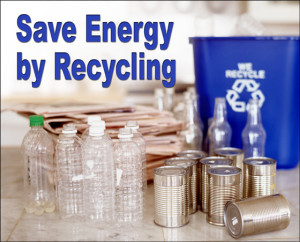Double the Benefits: Stretch Resources and Conserve Energy
Recycling reuses materials wisely. It is resource efficient. By recycling, we get more use from a material, avoiding dumping the material in a landfill— and conserve precious energy while we are doing it.
 How Does Recycling Save Energy?
How Does Recycling Save Energy?
Every raw material requires energy to be turned into a product. Producing consumer goods from virgin raw materials uses a lot of energy resources. Processing goods from recycled materials requires far less energy.
Recycled materials have been processed at least once. Turning recycled materials into new products is not only cleaner than using raw materials, it also demands far less energy.
Let us look at specific examples of energy savings possible with recycled materials.
RECYCLED ALUMINUM:
- The U.S. produces nearly 3.5 billion tons of aluminum each year.
- America recycles 100,000 aluminum cans per minute.
- Only 45% of aluminum cans are currently being recovered for recycling. If ALL the aluminum cans used annually were recycled, we would save enough energy to light Washington D.C. for 3.7 years!
- The aluminum cans produce in the U.S. in just one year, if laid end-to-end, could circle the globe— 169 times!
- It takes 95% less energy to produce an aluminum soda can from recycled cans than from raw material.
- Every ton of aluminum recycled saves 237.6 million Btu’s of energy, 40 barrels of oil, 270 cubic feet of landfill space— and prevents 10 tons of carbon emissions.
RECYCLED NEWSPAPERS:
- Today, 75% of all old newspapers are recycled in the U.S. — about 12.4 million tons per year.
- Recycled newsprint makes up 30% of newspapers.
- Recycled newspapers are also used to create other products, including cereal boxes, egg cartons, grocery bags, insulation, tissue paper, and other packaging and products.
- Newsprint can be recycled four times before the fiber breaks down too much to reuse.
- Every ton of newsprint recycled saves 10.2 million Btu’s of energy, 71 gallons of oil, 124.2 cubic feet of landfill— and prevents 2.5 tons of carbon emissions from being released into our atmosphere.
RECYCLED GLASS:
- Americans discard 11.4 tons of glass bottles and jars every year.
- Only 25% of glass is recycled.
- New glass contains an average of 30% recycled glass.
- Uses recycled glass to create new glass products reduces energy consumption by 21%.
- Recycling one glass bottle saves enough energy to light a 100-watt bulb for about four hours— or power a computer for 30 minutes.
- Every ton of glass recycled saves 714,000 Btu’s of energy, 5 gallons of oil, 54 cubic feet of landfill space— and reduces carbon emissions by .34 tons.
RECYCLED PLASTIC:
- According to the Environmental Protection Agency (EPA), Americans generate 32 million tons of plastic waste annually.
- The overall recycling rate for plastics is poor— only 13.3%. However, recycling for some types of plastic is much higher— 32.5% for PET (polyethylene terephthalate) bottles like soda and water bottles.
- Americans use 2.5 million plastic drink bottles per hour.
- The average American throws 185 pounds of plastic away every year.
- Americans use enough plastic wrap each year to wrap all of Texas!
- Recycling PET bottles saves 76% of the energy needed to create plastic from virgin materials.
- Plastic water bottles in landfills will not decompose for a thousand years or more!
- Every ton of plastic recycled saves 98 million Btu’s of energy, 685 gallons of oil, 810 cubic feet of landfill — and avoids dispersing 1.7 tons of carbon emissions.
RECYCLED STEEL:
- More steel is recycled annually than all aluminum, glass, paper, and plastic combined.
- Steel is easy and economical to separate from other discarded materials. Its magnetic properties allow huge electromagnetic devices to collect steel from other waste.
- Steel can be recycled an infinite number of times without losing any strength.
- In the U.S., steel cans are recycled at the rate of 600 cans per second.
- North Americans recycle over 80 million tons of steel each year.
- The steel is recycled from 100% of all junked automobiles.
- Recycling steel takes 60% less energy than creating steel from virgin materials.
- By using metal scrap instead of virgin materials to produce steel, carbon emissions are reduced by 58%.
- Recycling steel saves enough energy each year to supply Los Angeles with electrical power for TEN YEARS!
- One ton of recycled steel saves 10.9 million BTu’s of energy, 1.8 barrels of oil, 108 cubic feet of landfill area, 2,500 pounds of iron ore, 1,400 pounds of coal, and 120 pounds of limestone.
RHINO Steel Buildings Save Energy, Too!
- RHINO creates efficient, eco-friendly structures that last decades longer than other building materials.
- Our structures are designed and manufactured for maximum efficiency and drastically reduced waste.
- RHINO steel framing contains up to 90.7% recycled steel.
- The optional Pro-Value Insulation Package slashes energy consumption in half.
Learn about green building with RHINO by calling 940.383.9566 today.
